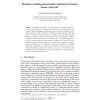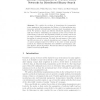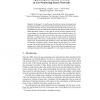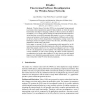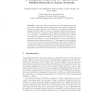98
Voted
EWSN
2008
Springer
16 years 12 days ago
2008
Springer
107
Voted
EWSN
2008
Springer
16 years 12 days ago
2008
Springer
Clustering is an important mechanism in large multi-hop wireless sensor networks for obtaining scalability, reducing energy consumption and achieving better network performance. Mo...
137
Voted
EWSN
2008
Springer
16 years 12 days ago
2008
Springer
Today it is possible to deploy sensor networks in the real world and collect large amounts of raw sensory data. However, it remains a major challenge to make sense of sensor data, ...
114
click to vote
EWSN
2008
Springer
16 years 12 days ago
2008
Springer
Abstract. We address the problem of designing practical, energy-efficient protocols for data collection in wireless sensor networks using predictive modeling. Prior work has sugges...
106
Voted
EWSN
2008
Springer
16 years 12 days ago
2008
Springer
We consider the problem of determining the transmission power assignment that maximizes the lifetime of a data-gathering wireless sensor network with stationary nodes and static tr...
107
click to vote
EWSN
2008
Springer
16 years 12 days ago
2008
Springer
In this paper3 , we use Bayesian Networks as a means for unsupervised learning and anomaly (event) detection in gas monitoring sensor networks for underground coal mines. We show t...
123
click to vote
EWSN
2008
Springer
16 years 12 days ago
2008
Springer
Wireless Sensor Networks (WSNs) are increasingly being proposed in scenarios whose requirements cannot be fully predicted, or where the system functionality must adapt to changing ...
93
Voted
EWSN
2008
Springer
16 years 12 days ago
2008
Springer
Sensors networks instrument the physical space using motes that run network embedded programs thus acquiring, processing, storing and transmitting sensor data. The motes commercial...
129
click to vote
EWSN
2008
Springer
16 years 12 days ago
2008
Springer
Component-based architectures are the traditional approach cile application specific optimization with reusable abstractions in sensor networks. However, they frequently overwhelm ...
92
Voted
EWSN
2008
Springer
16 years 12 days ago
2008
Springer
Abstract. We examine the problem of tracking dynamic boundaries occurring in natural phenomena using range sensors. Two main challenges of the boundary tracking problem are energy-...

